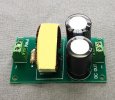Just picked up an old Aristo Craft set (RC Cola Taste Express) with the basic PWM controller. It’s nice to have more consistent lighting brightness and better smoke unit performance, but the high pitched whine of the motor on PWM drives me crazy. The locomotive runs quiet on a straight DC supply but the lights are significantly less bright and the (admittedly cheesy) steam chuffing sounds don’t work on straight DC (It must be generating the static sound from the PWM?). Is there a simple way to tame the whine without loosing the benefits of brighter lighting and better smoke?
Thanks for your thoughts!
Thanks for your thoughts!




